|
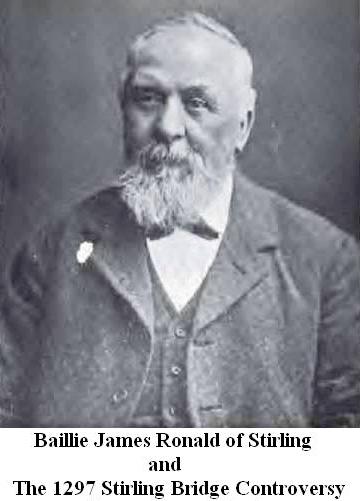
JAMES RONALD [Baillie, Historian, Stonemason and Housing
Developer in Stirling]
Christening: 01 JUN 1838 Stirling,
Stirling, Scotland
Death: 13th April, 1906, James Street, Stirling,
Scotland
Father: JAMES RONALD
Mother: JEAN FORREST
Extracted christening record for the locality listed in
the Old Parish Records.
Baillie James Ronald was a very able and versatile man,
and, among his contributions to the historical literature of Stirling were
lengthy and skilfully researched books and articles about the ‘Blackfriars
of Stirling’, and the ‘Landmarks of Old Stirling’, plus a convincing
critique with William B. Cook Esq. on the controversy over the location of
the bridge during the Battle of Stirling Bridge in 1297.
Around the turn of the century, Baillie Ronald arranged
for a number of streets in the Riverside Area of Stirling, where he had
built tenements, to be named after some of his family members, v.i.z. RONALD
PLACE after the family surname; FORREST ROAD after his mother Jean Forrest;
JAMES STREET after his father James Ronald and himself; and EDWARD AVENUE
after two of his sons, Edward Ronald and James Edward Ronald.
Here follows a collated .pdf file of the Stirling Bridge
Critique and References :-
Download the pdf file here!
Bailie Ronald
A MEMOIR
BY
David B. Morris.
JAMES RONALD, the author of this volume, was born in Stirling
in 1838. After three or four years of early childhood spent at
Charters-hall, he returned to the town, where he received his education at
Mr. Michael Jacob’s school in Friars Street, and at the mathematical classes
of the late Mr. Duncan M'Dougall. His father was a builder, and when James
left school, at the age of fifteen, he became apprenticed to that trade. The
first work at which he was engaged was the building of the High School, for
which his father was contractor. In his young manhood he was greatly
influenced by his uncle, William Forrest, a nailer at Chartershall, who
seems to have been in some ways a remarkable man. What struck young Ronald
chiefly in his uncle’s character was his unbending uprightness, and there
can be little doubt that this influence was wholly for the young man’s good,
and that it bore fruit in after years. To the last Mr. Ronald bore testimony
to the great respect in which he held the memory of his relative.
After finishing his apprenticeship, Mr. Ronald spent some
time in London, where he superintended the erection of a building for
Messrs. Nelson, the publishers. On his return to Stirling he began business
with the late Mr. William Dougall, under the firm name of Dougall & Ronald.
On Mr. Dougall’s retiral, Mr. Ronald carried on the business until it was
taken over by his two sons about a year before his death. Many important
buildings in Stirling and district were built by him. So thorough was all
his work that he enjoyed the most implicit confidence of the architects and
of all who employed him. Among his workmen Mr. Ronald was regarded with
great respect and affection, and many of them were for a lifetime in his
service. Mr. Ronald had a great knowledge of buildings and their value, and
his services were frequently called in as arbiter, or valuator, or adviser
in all matters concerning house property.
For many years Mr. Ronald took a deep interest in the public
affairs of his native town. His first appearance as a municipal
representative was in 1876, when he was elected by the ratepayers to the
Stirling Waterworks Commission. Two years afterwards he entered the Town
Council, sitting for Baker Street Ward, and he continued in the Council
until 1892. He was elected a Bailie in 1884, and after serving in that
capacity for five years he was appointed Honorary Treasurer. He was a
Governor of the Stirling Educational Trust for ten years. Of Mr. Ronald’s
work in the Town Council and the strenuous doings in which he was a
participator, this is not the place to speak. Suffice it to say that in all
he did he carried the respect of friend and opponent alike. In the words of
his old colleague, Provost Thomson,—“What he did he did with all his might,
giving his best energies to his own business, of which he was a capable
master, and also to the service of the town, of which he was so worthy and
respected a citizen. I think the word, thorough, was specially
characteristic of him and his work.”
Mr. Ronald was a member of the Free South Church, in which he
was for many years an elder, and was the close friend of its succession of
worthy ministers, the Revs. Alexander Leitch, W. F. Goldie, and John Arnott.
The old church, and all that concerned its welfare, were close to his heart
When, in 1902, the centenary of the erection of the church was celebrated,
shortly before the congregation removed to their present church in Murray
Place, it was suggested that Mr. Ronald should write the history of the old
building behind the High School. This he did, and at the afternoon service
on 4th May, Mr. Arnott read it to a keenly interested audience. The paper
was published in a little booklet, under the title of “The Story of the
South Church, Stirling.”
It was as a local antiquary that Mr. Ronald performed the
work for which his name will be chiefly remembered, and it was through the
medium of the Stirling Natural History and Archaeological Society that most
of the results of his research saw the light. He became a member of the
Society on 14th November, 1889, the evening on which he read the first part
of his first paper, namely, that entitled “The Story of the Parish Church of
Stirling.” The great value of the paper as a bit of original research was at
once recognised, and Mr. Ronald was henceforward looked upon as an authority
on the subject of local antiquities. It was thus somewhat late in life that
Mr. Ronald took up literary work, and it is interesting to have his own
explanation of the circumstances which led him to undertake what proved such
a congenial task. In the preface to his volume on “Landmarks of Old Stirling,”
he says, “When holding office in the Town Council of Stirling some years
ago, I had frequent opportunities of scanning the interesting old records
and other documents in the Burgh Chambers, and I had not gone far in my
perusal of them until I discovered that they contained a perfect mine of
materials fitted to throw light on the ancient buildings, lands, and crofts
of our good old burgh. The papers contained in this volume are in great
measure the result of these researches.” The first subject to which he gave
attention was the localising of places mentioned in the Burgh records. In
the course of his investigation he came across many interesting entries as
to the Parish Church, and, leaving the ancient localities to another day, he
plunged into the story of that building. This was to him a most congenial
subject, owing to the deep religious element which was in his nature, and to
his knowledge of, and keen interest in, all matters pertaining to
architecture. He had also a strong sympathy for the human story which the
fine old building on the hill could tell to the patient investigator. He
believed the words of Ruskin, which he quoted, to be specially true of our
church, “that the greatest glory of a building is not in its stones or in
its gold; its glory is in its age, and in that deep sense of voicelessness,
of stern watching, of mysterious sympathy, which we feel in walls that have
long been washed by the passing waves of humanity.” Such were Mr. Ronald’s
sentiments in regard to the Parish Church of Stirling. In this paper he set
for ever at rest the belief that the Greyfriars ever had anything to do with
the building.
Mr. Ronald was from time to time asked to conduct over the
church societies or parties specially interested in the subject, and to
explain its architectural features. Such requests brought about a struggle
between his natural diffidence, which inclined him to say “No,” and his
enthusiasm for the ancient structure, which influenced him to say “Yes.” If
the latter prevailed, the party found in Mr. Ronald a most reliable guide,
whose words, if few, threw a flood of light on what he believed to be the
most ancient and interesting building in the town, and on the development of
ecclesiastical and burghal life, of which for centuries it had been a silent
witness. He read a paper to the Aberdeen Ecclesiological Society when they
visited the church in September, 1899, and another paper to the Edinburgh
Architectural Association, on their visit in May, 1903.
Having finished his paper on the Parish Church, Mr. Ronald
returned to' his investigations into the “Names and Localities of the Old
Lands and Crofts in and around Stirling,” under which title he read a paper
to the Stirling Natural History and Archaeological Society in October, 1890.
When Mr. Renwick, Depute Town Clerk of Glasgow, was preparing for the press
one of the volumes of the Burgh Records of Stirling, it occurred to him to
ask Mr. A. B. M‘Donald, City Engineer, Glasgow, to prepare a plan of
Stirling in the seventeenth century, a task for which Mr. M‘Donald, being a
native of Stirling, was peculiarly fitted. Mr. M‘Donald agreed, and meeting
Mr. Ronald soon after, the matter was discussed, and Mr. Ronald promised to
assist in getting information. This set him to reading the old records in
the possession of the Town Council, and was the circumstance from which all
his antiquarian labours grew. Mr. M‘ Donald’s plan was published in the
volume of Burgh Records, but by the time Mr. Ronald read his paper, some
farther facts had been ascertained, and the plan, with some additional
detail, was re-published along with Mr. Ronald’s volume on “Landmarks of Old
Stirling.” At the close of the paper, he added a note on “The Ancient Bridge
of Stirling in 1297,” to which reference will hereafter be made.
In all Mr. Ronald’s investigations, one subject led to
another. His previous paper had suggested “The Story of the Old Bridge of
Stirling” (by which is meant the old bridge still standing). Indeed, he had
contemplated telling that story as part of the paper on “Names and
Localities,” but the materials grew upon him in such a way that he had to
postpone dealing with the bridge until the following year. In December,
1891, his paper on that subject was read. This paper, dealing as it did with
the defence of the town, led naturally to that on “The Town Wall of Stirling”
read in November, 1893. Referring to the portion of the wall still standing,
the paper concluded with the “hope that the wall may long be allowed to
stand as a memorial of the past history of the burgh and a witness to the
struggles of our forefathers for independence and freedom,” a sentiment
which we should like to see shared by every inhabitant of the buigh. In this
paper Mr. Ronald identified with great exactness the sites of the various
“ports” or gates, and at his instance the places where the “Barrasyett,” at
the junction of Port Street and Dumbarton Road, and the “New Port,” in the
middle of King Street, were situated, were marked by letters formed of red
granite blocks inserted in the causeway of the street In January, 1894, the
late Mr. T. L. Galbraith, Town Clerk, received from the late Marquis of Bute
a memorandum stating that he had in contemplation a heraldic work dealing
with the Municipal Arms of the Burghs of Scotland, including Burgh Seals,
and desiring to be supplied with information as to the seals of Stirling.
Mr. Galbraith spoke to Mr. Ronald, and what information could be gathered
was sent on. The volume was published in 1897, under the following title,
“The Arms of the Royal and Parliamentary Burghs of Scotland," Messrs. J. R.
N. Macphail and H. W. Lonsdale being associated with the Marquis of Bute in
the authorship. Due acknowledgment was made of the authors’ obligations to
Mr. Ronald for the use of his valuable and interesting notes. It occurred to
Mr. Ronald to go a little farther into the subject, and so he put together a
good deal of information bearing on the old seals of the burgh and
interesting occasions on which they had been used, and the result formed a
paper read to the Society in October, 1895.
In March, 1896, Mr. Ronald contributed a paper on “The
Ancient Parish of Stirling,” written in a style more controversial than was
his wont. The paper was compiled with the object of refuting an opinion
expressed by the Rev. David Smith, in a paper read to the Society a year
before, that there is evidence of a time when Stirling was in the Parish of
St. Ninians. Mr. Ronald’s firm opinion was that the parishes of Stirling and
St. Ninians never were other than separate and distinct.
In 1899 the papers which have been mentioned, and which had
all been published in the Transactions of the Stirling Natural History and
Archaeological Society, were reprinted and published by Mr. Eneas Mackay, of
Stirling, in a handsome volume entitled, “Landmarks of Old Stirling.”
Whoever made the suggestion to Mr. Ronald did an excellent thing, as the
papers were well worthy of being collected and published in a more
convenient form than scattered through the different numbers of a Society's
Transactions. The volume is now a standard work on old Stirling, to which
the future antiquary must needs refer, and is a model of what such a book
should be. Included in the volume is a chapter on the Old Manse of Stirling,
which was situated in St. John Street, with a short account of the ministers
who lived in it, and also a chapter on the Old Market Cross of Stirling.
When the cross was re-erected in 1891, Mr. Ronald had been consulted as to
the form of the restoration, and some difference of opinion had arisen as to
whether the surrounding steps should be circular, as appeared should be the
case from certain records, or octagonal, as might have been thought likely
from the pillar being eight sided. Mr. Ronald took the former view, and the
cross now stands in Broad Street with four circular steps for its base.
Mr. Ronald’s next work was a paper read to the Society in
January, 1902, on “The Crafts of Stirling,” in which the story of the
Incorporated Trades and their association with -Spittal’s Hospital was fully
disclosed. It is understood that Mr. Ronald contemplated a farther paper on
this subject, dealing with the history of the different incorporations
separately, but this, like various other projected pieces of antiquarian
work, it was destined he should not live to accomplish.
“On finding part of an old wall in Murray Place,” was the
cautiously-expressed title of a paper read in April, 1904. Mr. Ronald had
been engaged in taking down a tenement of houses in Murray Place for
re-erection, when he came upon a mass of building, under the tenement, and
extending into the garden. There is little doubt that Mr. Ronald was right
in his conjecture that he had thus accidentally hit upon part of the
foundation of a wall of the church connected with the old Blackfriars
Monastery. This was a most important antiquarian find, and it was a piece of
singular good fortune that Mr. Ronald should have been the builder engaged
in the work, as otherwise the discovery might never have been made or
followed up.
In November, 1904, the Society listened to still another
paper, the last to be read in Mr. Ronald’s lifetime, entitled, “The Earl of
Mar’s Ludging.” Shortly thereafter it was published by Mr. Mackay, in a
separate volume, as an introduction to the Household Book of Lady Marie
Stewart, the volume also containing a series of drawings of the building by
Mr. J. W. Small, with explanatory notes. This -paper was not so complete as
had been expected, but Mr. Ronald had made it only, what it purported to be,
an introduction. It by no means exhausted Mr. Ronald’s store of information,
and it is satisfactory to know that a supplementary paper on this important
subject was left completed among his papers at his death, and is to be given
to the Archaeological Society next session.
The closing months of Mr. Ronald’s life were much occupied by
a subject to which he had given a good dead of time and thought. In his
paper on “Old Landmarks,” in 1890, he took up the site of the Ancient Bridge
of Stirling, that was destroyed at the Battle of Stirling, in 1297. In spite
of the prevadence of the belief that the bridge was situated at Kildean, Mr.
Ronald held that it stood at or near the site of the present old bridge. He
gave a short, but convincing, statement of the reaisons which induced him to
form that opinion. Mr. Ronald’s view commended itself to many who haul
previously given the matter little thought, and, although some have not been
convinced, may be said now to hold the field. To the accomplishment of this
result there contributed, in no small degree, an exhaustive paper by Mr. W.
B. Cook, on the Battle of Stirling Bridge, read to the Society in January,
1905. Mr. Cook’s paper had revived interest in the subject, and Mr. Ronald,
in the enforced leisure of failing health, again turned his attention to it.
Matters were in this position when the exceptional drought of the spring and
summer of 1905 came on, and the River Forth sank to a level lower than the
oldest inhabitant could remember. What followed I shall give, as far as
possible, in Mr. Ronald’s own words, in an autobiographical fragment,
entitled “A Bit of Private History,” sent by him to me a few months before
his death. “I was born in Bridge Street, right opposite the Rev. J. Angus’
church. My mother died a few weeks after. I was then sent to my
grandmother’s, at Chartershall, where I lived for three or four years, after
which I was taken back to Bridge Street. At that time our supply of water
came from Lessfeerie, and was miserably inadequate. Householders had to be
very careful of the water, even for cooking purposes, while for washing-days
it had to be carried from the Forth. We youngsters had to do all this, so
that it seemed as if the river was more useful then than now. Things went on
in this quiet way until I reached my tenth year, when I witnessed the
drowning of a man, just opposite to where the piers are, in a deep, dark
pool, beneath an overhanging tree, on the Winchelhaugh side of the river. I
did not get the cries of that man out of my ears for a twelvemonth; indeed
it had an influence on my whole life, and ever since I have had a horror of
water, and have been very seldom on it.” In Mr. Ronald’s employment was a
man named Connelly, who, from having been a pearl fisher, was familiar with
the bed of the river. He had mentioned to Mr. Ronald the existence of two
projections, apparently of stone wprk, which rise from the bottom of the
stream from 65 to 75 yards above the present Old Bridge, and were known to
pearl fishers and others who had occasion to be on the river. Mr. Ronald
conceived the idea that these might be fragments of the piers of the ancient
bridge, and he had often turned the matter over in his mind. Now, when the
river fell so low that a sandbank, which had accumulated on the southmost of
the projections, was exposed above the surface, so that the sea birds
gathered on it from day to day, the unusual sight spurred Mr. Ronald to
action. He says, “At this time I was forbidden by the doctor to go up
streets, and ordered to keep to the level. My walks were thus confined
mainly to the riverside. I usually sat on the seat nearest to the bridge,
where I saw the cars passing, and heard the rumble of town life. While thus
engaged, I observed the low state of the river at ebb tide. This went on day
by day, and was a great temptation to me, for though my body was weak, my
mind was strong, and my brain ever busy. I said to myself I had often wished
to examine those piers, and here was an opportunity I might never get again.
I had the man Connelly, who had known all about them for many years,
everything was favourable, some mysterious force was urging me: the
temptation became too strong, I forgot my horror of the river, and spoke to
Connelly about the matter, and arranged a day for it The rest you know. All
the same it was a most foolish and foolhardy action on my part in my then
state of health.” The result of Mr. Ronald’s investigations was made public
in two letters to the "Stirling Sentinel,” published on 13th and 20th June,
1905. The position of the piers and their dimensions, though approximate
only, were set forth with considerable detail, and also the depth of the
water at various points, showing that Mr. Ronald’s examination had been
conducted with his usual care and thoroughness. The matter has not meantime
been any farther cleared up, but it is possible that future investigation
may determine definitely the real nature of these structures.
The last work upon which Mr. Ronald was engaged was that
which now appears in the present volume, “The
Story of the Argyle Lodging," the last fruits of a busy career. During
the closing weeks of his life, although his strength was ebbing fast, Mr.
Ronald stuck to his voluntary task, and he had the satisfaction of seeing it
completed. The final proof sheets had been corrected, he put aside his pen,
and then laid himself down to take his eternal rest. Mr. Ronald had planned
out two papers for which he had collected a quantity of information, but
these were never written. One was the history of the Old Tolbooth, and the
other that of Stirling Castle. It was his opinion that the latter would be
his most important work, and we can well understand what a valuable
historical volume it would have been, had Mr. Ronald been spared to write
it. He felt the magnitude of the task, and realized keenly the necessity for
its being done thoroughly and well, and had his health allowed, he was
prepared to brace himself for a work which would have been of national
importance. But, alas, it has been ruled otherwise, and where is the man to
take his place?
Words of eulogy are not needed to sum up this inadequate
account of Mr. Ronald’s life. His work and achievements speak for
themselves; his character was what every one knew it, honourable,
unassuming, sternly upright and quietly kind,—more, it was, what his more
intimate friends knew well, founded on a deep sense of religious feeling,
and in spite of an apparently unpoetic exterior, full of intense sentiment
He had the practical man’s love of exactness and plain statement of fact,
qualities essential to the antiquary, but he had also in his being a spring
of imagination, which, in spite of repression, burst out from time to time,
a quality not less necessary to the successful worker in any field of
research. We wonder how one, whose hands were so full of business, could
have found time to overtake so much careful investigation of records, and to
accomplish so much literary work, but we have only to recall what was Mr.
Ronald’s outstanding characteristic, to find the explanation in his
tremendous tenacity of purpose. There are few of Stirling’s sons whose
remains have been followed to our beautiful cemetery on the hill who could
be less spared than our old familiar friend, Bailie Ronald.
DAVID B. MORRIS.
15th June, 1906.
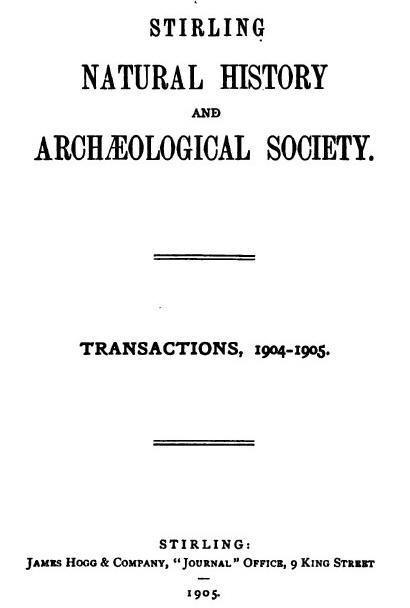
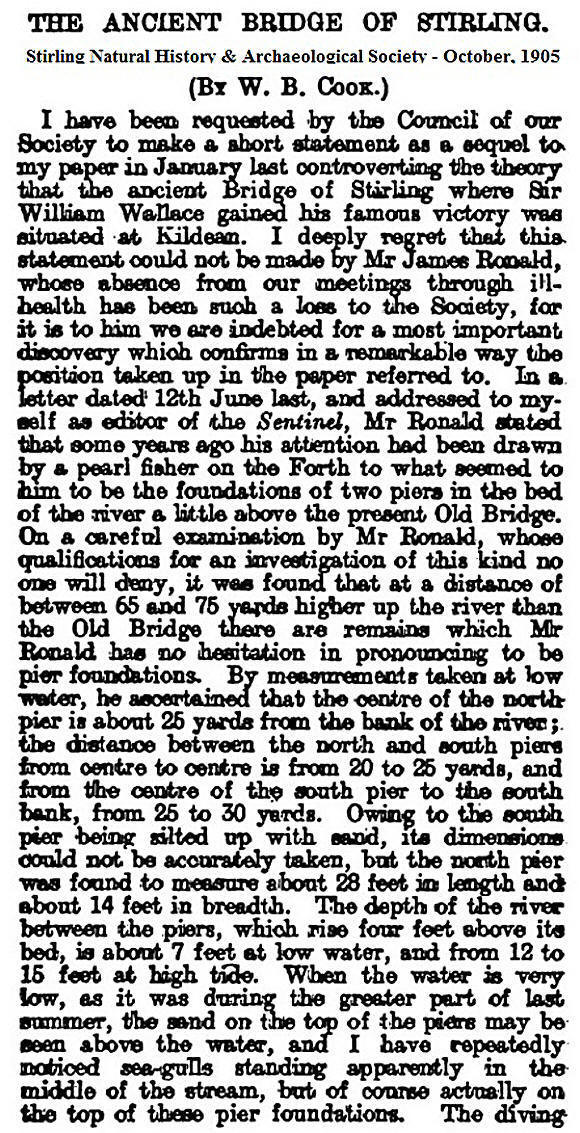
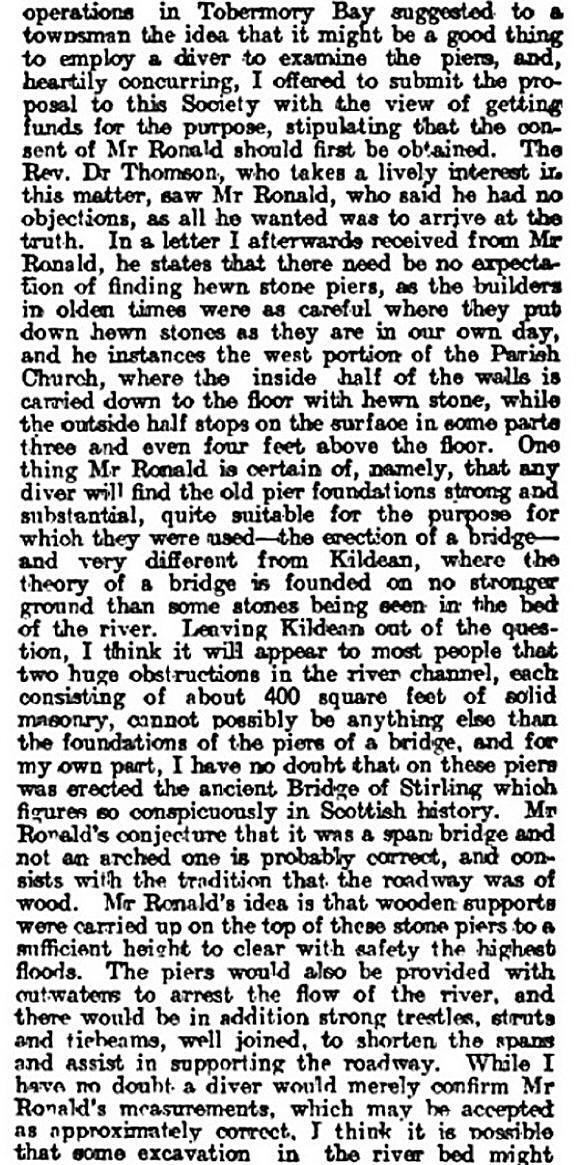
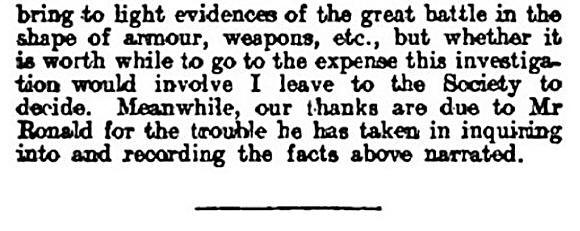
The Kildean Myth (pdf) |

